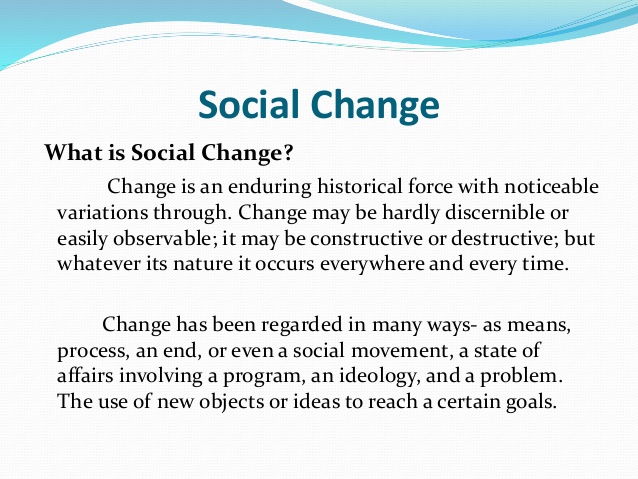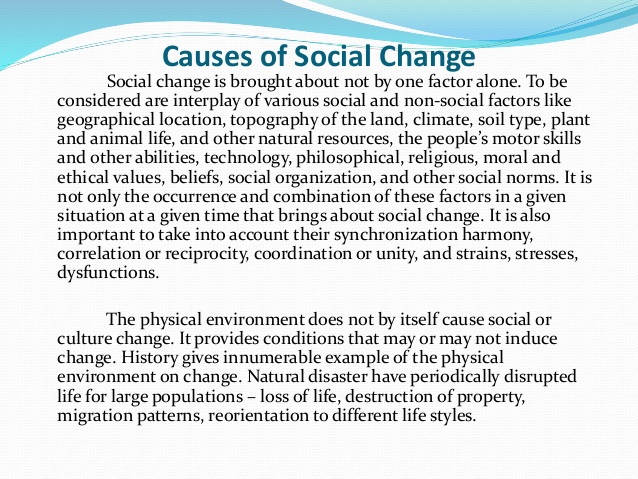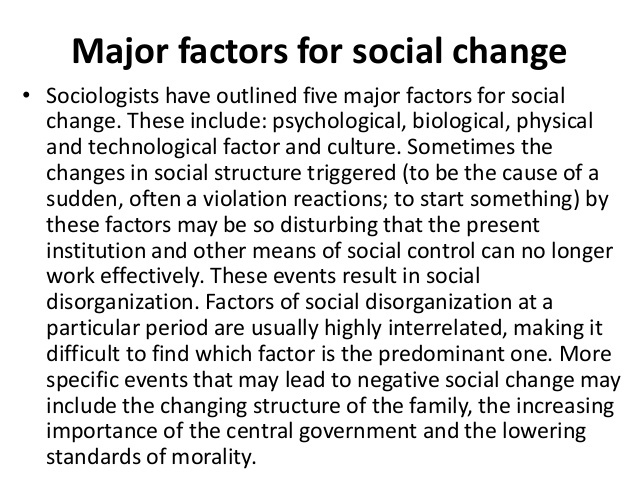Relevance: Sociology: Paper I: Social Change
Social change is a change in the social structures and functions of those Structures. The term social change is also used to indicate the changes that take place in human interactions and interrelations. For example Change in Structure and Functions of family (Joint to Nuclear Structure of Family and Change in functions of family).
For Maciver and Page, Society is a web of social relationships and hence social change means change in the system of social relationships. These are understood in terms of social processes and social interactions and social organization.
Auguste Comte the father of Sociology has posed two problems- the question of social statics and the question of social dynamics, what is and how it changes. The sociologists not only outline the structure of the society but also seek to know its causes also.
According to Morris Ginsberg social change is a change in the social structure.
Change is the law of nature. What is today shall be different from what it would be tomorrow. The social structure is subject to incessant change.. Individuals may strive for stability, societies may create the illusion of permanence, the quest for certainty may continue unabated, yet the fact remains that society is an everchanging phenomenon, growing, decaying, renewing and accommodating itself to changing conditions and suffering vast modifications in the course of time.
Our understanding of it will not be complete unless we take into consideration this changeable nature of society, study how differences emerge and discover the direction of change.
Forms of Social Change
Generally social change occurs in two forms.
- Change in the system:- It means all the small changes occurring in the system come under this form of social change. Karl Marx has described it in the form of quantitative changes. Such changes keep going on in all the societies like premature communism, ancient society, similarly plenty of changes coming up in modern societies in all areas are the ways of change in the system. Given so much importance to children and women in today’s family, is indicator of change in relations. Parsons has also talked about such kind of change.
- Change of the system:- Though, this form of change, brings change in the whole system, for eg the qualitative change explained by Karl Marx described, this kind of change, because under qualitative change, the whole system is replaced by another system. Similarly, if it happens that in India, caste system in completely abolished and absolute class system is established then it would be said to be change of the system.
Direction of Social Change:
- Though there is not any fixed direction of change and so there is nothing absolute to describe it. But maclver and Page have given, in general, the following directions of change
- Forward direction of change: Shows a definite positive change. This is usually seen in the field of science and technology, which in turn, change the existence of life and knowledge.
- Downward/Backward direction of change:– Some changes occur, upwards initially but later on a process of degeneration starts, economic change in the best example of it. Metropolitan cities also decay after a big change. In International market also this kind of change in seen.
- Wave Like change: – Another direction of change happens as a wave ambulance like motion and example of such kind of changes are seen in the field of fashion, styles of living, attires etc. Which after sometime repeat itself. It does not have any fixed direction of high level of change.
Factors of Social Change
- Internal Factors:- Change in population and geographical conditions, change in production process migration, Individual interests, communal conflicts, change in physical consumerism like in science and technology industrialization, urbanization, consumerism lifestyle etc.
- External Factors:– Cultural contact is the main external factor, which could be direct or indirect and which beings change in the form of acculturation, assimilation and diffusion for eg. India realized change under the direct influence of Islam and Western culture and especially westernization has put a great impact on our societies, in all spheres of life.
Nature of Social Change:
- Social change is a universal phenomenon. Social change occurs in all societies. No society remains completely static. This is true of all societies, primitive as well as civilized. Society exists in a universe of dynamic influences. The population changes, technologies expand, material equipment changes, ideologies and values take on new components and institutional structures and functions undergo reshaping. The speed and extent of change may differ from society to society. Some change rapidly, others change slowly.
- Social change is community change. Social change does not refer to the change in the life of an individual or the life patterns of several individuals. It is a change which occurs in the life of the entire community. In other words, only that change can be called social change whose influence can be felt in a community form. Social change is social and not individual.
- Speed of social change is not uniform. While social change occurs in all societies, its speed is not uniform in every society. In most societies it occurs so slowly that it is often not noticed by those who live in them. Even in modern societies there seems to be little or no change in many areas. Social change in urban areas is faster than in rural areas.
- Nature and speed of social change is affected by and related to time factor. The speed of social change is not uniform in each age or period in the same society. In modern times the speed of social change is faster today than before 1947. Thus, the speed of social change differs from age to age. The reason is that the factors which cause social change do not remain uniform with the change in times. Before 1947 there was less industrialization in India, after 1947 India has become more industrialized. Therefore, the speed of social change after 1947 is faster than before 1947.
- Social change occurs as an essential law. Change is the law of nature. Social change also is natural. It may occur either in the natural course or as a result of planned efforts. By nature we desire change. Our needs keep on changing. To satisfy our desire for change and our changing needs social change becomes a necessity. The truth is that we are anxiously waiting for a change. According to Green “The enthusiastic response of change has become almost a way of life.”
- Definite prediction of social change is not possible. It is difficult to make any prediction about the exact forms of social change. There is no inherent law of social change according to which it would assume definite forms. We may say that on account of the social reform movement untouchability will be abolished from the Indian society; that the basis and ideals of marriage laws passed by the government; that industrialization will increase the speed of urbanization but we cannot predict the exact forms which social relationships will assume in future. Likewise it cannot be predicted as to what shall be our attitudes, ideas, norms and values in future.
- Social change shows chain-reaction sequence. A society’s pattern of living is a dynamic system of inter-related parts. Therefore, change in one of these parts usually reacts on others and those on additional ones until they bring a change in the whole mode of life of many people. For example, industrialism has destroyed the domestic system of production. The destruction of domestic system of production brought women from the home to the factory and the office. The employment of women meant their independence from the bondage of man. It brought a change in their attitudes and idea. It meant a new social life for women. It consequently affected every part of the family life.
- Social change results from the interaction of a number of factors. Generally, it is thought that a particular factor like changes in technology, economic development or climatic conditions causes social change. This is called monistic theory which seeks to interpret social change in terms of one single factor. But the monistic theory does not provide an adequate explanation of the complex phenomenon of social change. As a matter of fact, social change is the consequence of a number of factors. A special factor may trigger a change but it is always associated with other factors that make the triggering possible. The reason is that social phenomena re mutually interdependent. None stand out as isolated forces that bring about change of themselves. Rather each is an element in a system. Modification of one part influences the other parts and this influence the rest, until the whole is involved.
- Social change are chiefly those of modification or of replacement. Social changes may be broadly categorized as modifications or replacements. It may be modification of physical goods or social relationships. For example, the form of our breakfast food has changed. Though we eat the same basic materials which we ate earlier, wheat, eggs, corn, but their form is changed. Ready-to-eat-cornflakes, breads, omlettes are substituted for the form in which these same materials were consumed in yester years. There may also be modifications of social relationships. The old authoritarian family has become the small equalitarian family, the one room school has become a centralized school. Our ideas about women’s rights, religion, government and co-education stand modified today.




